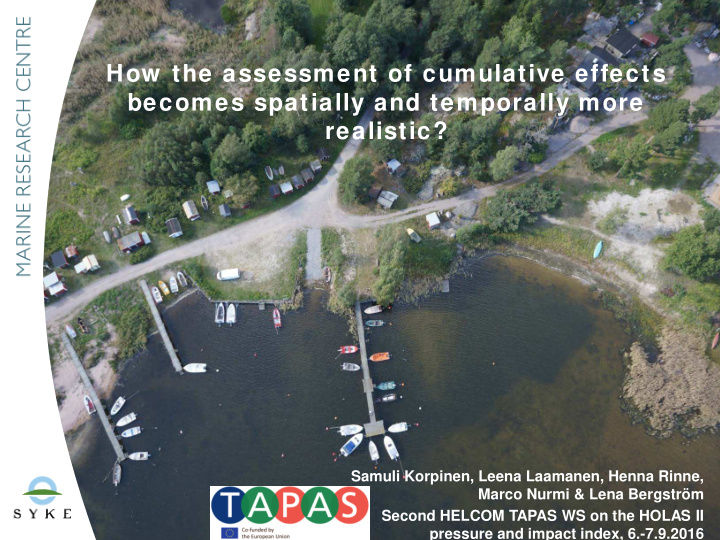



How the assessment of cumulative effects becomes spatially and temporally more realistic? Samuli Korpinen, Leena Laamanen, Henna Rinne, Marco Nurmi & Lena Bergström Second HELCOM TAPAS WS on the HOLAS II pressure and impact index, 6.-7.9.2016
Impact chains from activities to pressures and Sectors and impacts human activities Pressures Impacts on specific habitats and species
How to make the aggregated pressure layers? Lost seabed habitat (km 2 ): Cumulative sum over the assessment period. Spatial overlaps avoided. Physical disturbance (several metrics): Average of the annual number between the assessment years. All species summed/ averaged? Fish catch (tons): Average of the annual number between the assessment years. All species summed. Inputs (tons): Hunted/killed animals Average of the annual (individuals): number between the assessment years. All Average of the annual number nutrients summed. between the assessment years. All 3 species summed/ averaged?
How to aggregate pressures of different metrics? Physical disturbance Biological disturbance Inputs of contaminants Category Human activity Weight >80-100% Bottom-trawling fishery 1 Bottom-trawling fishery Pressure magnitude Capital dredging Capital dredging >60-80% Disposal of dredged 0.8 Disposal of dredged matter matter Sand extraction Sand extraction >40-60% 0.6 >20-40% Shipping Shipping 0.4 0.2 >0-20% 4
How to apply the pressure gradients to the data layers? Spatial ’buffer’ around the points/lines/polygons : - Initial scores by the TAPAS project team - BalticBOOST literature review - TAPAS expert survey Riverine pollution : - Satellites images from spring-time turbidity is used as the proxy for inputs of nutrients, contaminants and possibly other substances such as suspended solids or organic matter. 5
Attenuation of pressures from their source Type A Type B Type C Type D Two sources of information: - Expert survey - BalticBOOST literature review Riverine gradients taken directly from the satellite images. 6
Energy affects the pressure intensity Physical disturbance Input of nutrients Input of contaminants Input of beach litter Input of org. matter Input of heat 7
Water depth suppresses some pressures Which pressures attenuate towards deeper waters? Disturbance of species Input of heat Changes to hydrological due to human presence conditions Shipping: physical disturbance Which curves could describe that? Type A Type B Type C Type D 8
How to consider different temporal frequency of pressures in the data layers? Pressures accumulating over years Physical loss Input of litter Introductions of NIS Pressures taking place less frequently All others. E.g. nutrient inputs are taken up by the primary production, fish stocks reproduce, sediment disturbance settles, etc. Seasonality of the pressures and ecosystem components 9
10
Recommend
More recommend